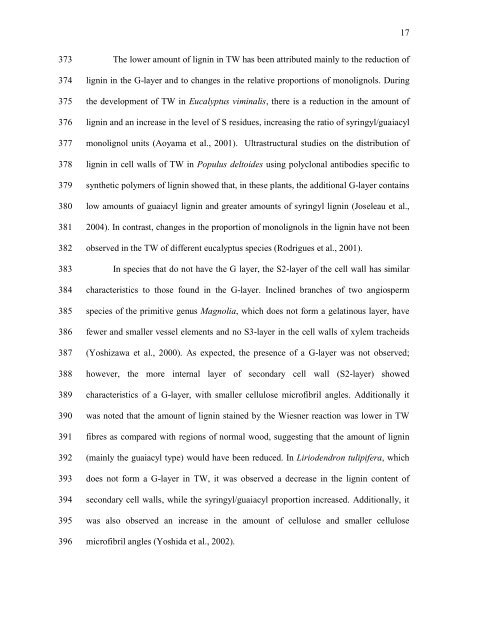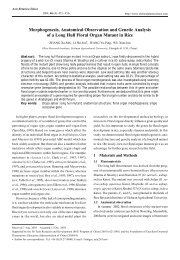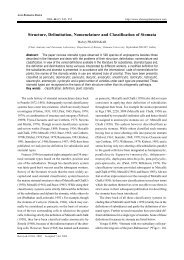Abiotic and biotic stresses and changes in the lignin ... - ResearchGate
Abiotic and biotic stresses and changes in the lignin ... - ResearchGate
Abiotic and biotic stresses and changes in the lignin ... - ResearchGate
You also want an ePaper? Increase the reach of your titles
YUMPU automatically turns print PDFs into web optimized ePapers that Google loves.
17<br />
373<br />
374<br />
375<br />
376<br />
377<br />
378<br />
379<br />
380<br />
381<br />
382<br />
383<br />
384<br />
385<br />
386<br />
387<br />
388<br />
389<br />
390<br />
391<br />
392<br />
393<br />
394<br />
395<br />
396<br />
The lower amount of lign<strong>in</strong> <strong>in</strong> TW has been attributed ma<strong>in</strong>ly to <strong>the</strong> reduction of<br />
lign<strong>in</strong> <strong>in</strong> <strong>the</strong> G-layer <strong>and</strong> to <strong>changes</strong> <strong>in</strong> <strong>the</strong> relative proportions of monolignols. Dur<strong>in</strong>g<br />
<strong>the</strong> development of TW <strong>in</strong> Eucalyptus vim<strong>in</strong>alis, <strong>the</strong>re is a reduction <strong>in</strong> <strong>the</strong> amount of<br />
lign<strong>in</strong> <strong>and</strong> an <strong>in</strong>crease <strong>in</strong> <strong>the</strong> level of S residues, <strong>in</strong>creas<strong>in</strong>g <strong>the</strong> ratio of syr<strong>in</strong>gyl/guaiacyl<br />
monolignol units (Aoyama et al., 2001). Ultrastructural studies on <strong>the</strong> distribution of<br />
lign<strong>in</strong> <strong>in</strong> cell walls of TW <strong>in</strong> Populus deltoides us<strong>in</strong>g polyclonal antibodies specific to<br />
syn<strong>the</strong>tic polymers of lign<strong>in</strong> showed that, <strong>in</strong> <strong>the</strong>se plants, <strong>the</strong> additional G-layer conta<strong>in</strong>s<br />
low amounts of guaiacyl lign<strong>in</strong> <strong>and</strong> greater amounts of syr<strong>in</strong>gyl lign<strong>in</strong> (Joseleau et al.,<br />
2004). In contrast, <strong>changes</strong> <strong>in</strong> <strong>the</strong> proportion of monolignols <strong>in</strong> <strong>the</strong> lign<strong>in</strong> have not been<br />
observed <strong>in</strong> <strong>the</strong> TW of different eucalyptus species (Rodrigues et al., 2001).<br />
In species that do not have <strong>the</strong> G layer, <strong>the</strong> S2-layer of <strong>the</strong> cell wall has similar<br />
characteristics to those found <strong>in</strong> <strong>the</strong> G-layer. Incl<strong>in</strong>ed branches of two angiosperm<br />
species of <strong>the</strong> primitive genus Magnolia, which does not form a gelat<strong>in</strong>ous layer, have<br />
fewer <strong>and</strong> smaller vessel elements <strong>and</strong> no S3-layer <strong>in</strong> <strong>the</strong> cell walls of xylem tracheids<br />
(Yoshizawa et al., 2000). As expected, <strong>the</strong> presence of a G-layer was not observed;<br />
however, <strong>the</strong> more <strong>in</strong>ternal layer of secondary cell wall (S2-layer) showed<br />
characteristics of a G-layer, with smaller cellulose microfibril angles. Additionally it<br />
was noted that <strong>the</strong> amount of lign<strong>in</strong> sta<strong>in</strong>ed by <strong>the</strong> Wiesner reaction was lower <strong>in</strong> TW<br />
fibres as compared with regions of normal wood, suggest<strong>in</strong>g that <strong>the</strong> amount of lign<strong>in</strong><br />
(ma<strong>in</strong>ly <strong>the</strong> guaiacyl type) would have been reduced. In Liriodendron tulipifera, which<br />
does not form a G-layer <strong>in</strong> TW, it was observed a decrease <strong>in</strong> <strong>the</strong> lign<strong>in</strong> content of<br />
secondary cell walls, while <strong>the</strong> syr<strong>in</strong>gyl/guaiacyl proportion <strong>in</strong>creased. Additionally, it<br />
was also observed an <strong>in</strong>crease <strong>in</strong> <strong>the</strong> amount of cellulose <strong>and</strong> smaller cellulose<br />
microfibril angles (Yoshida et al., 2002).







